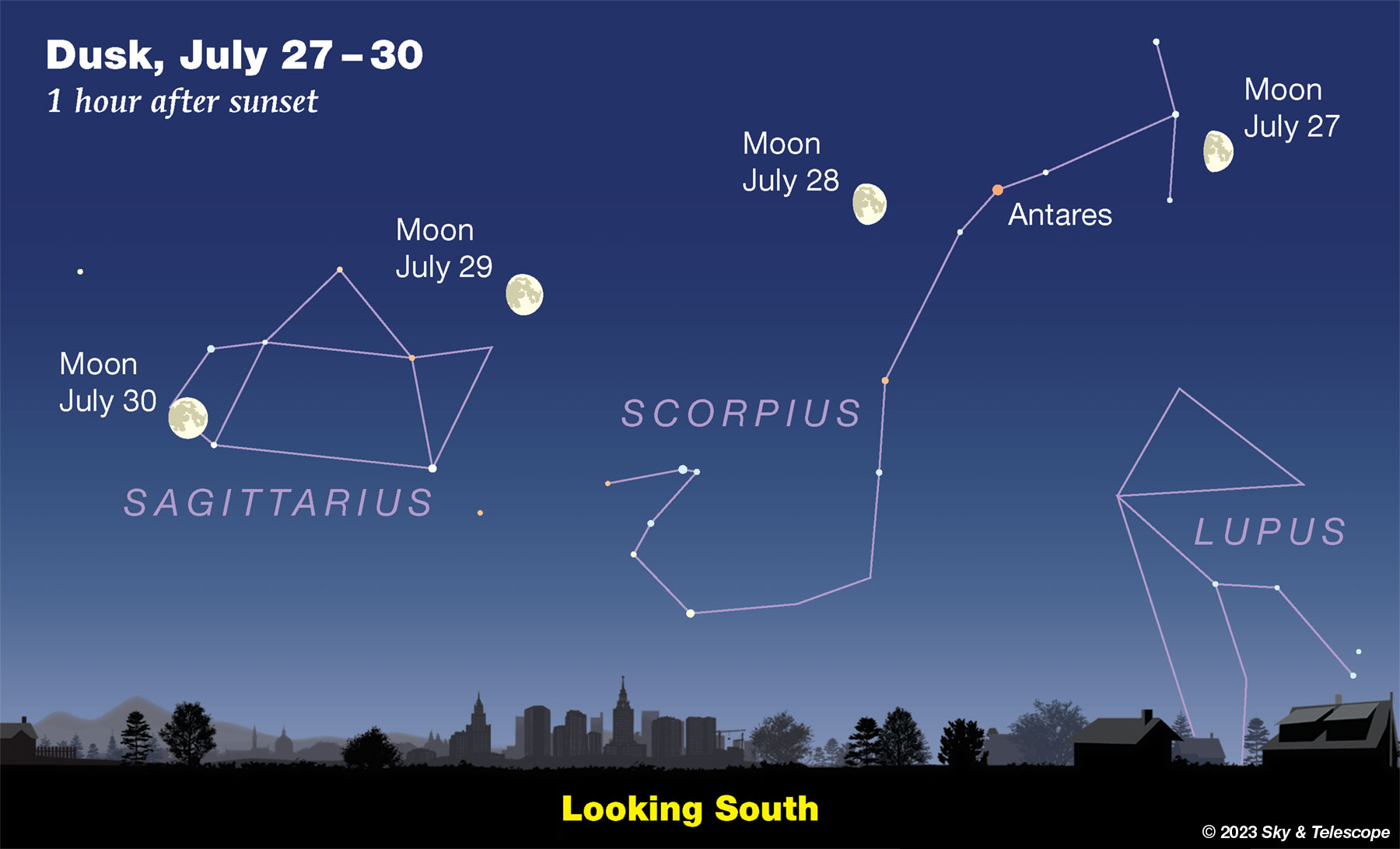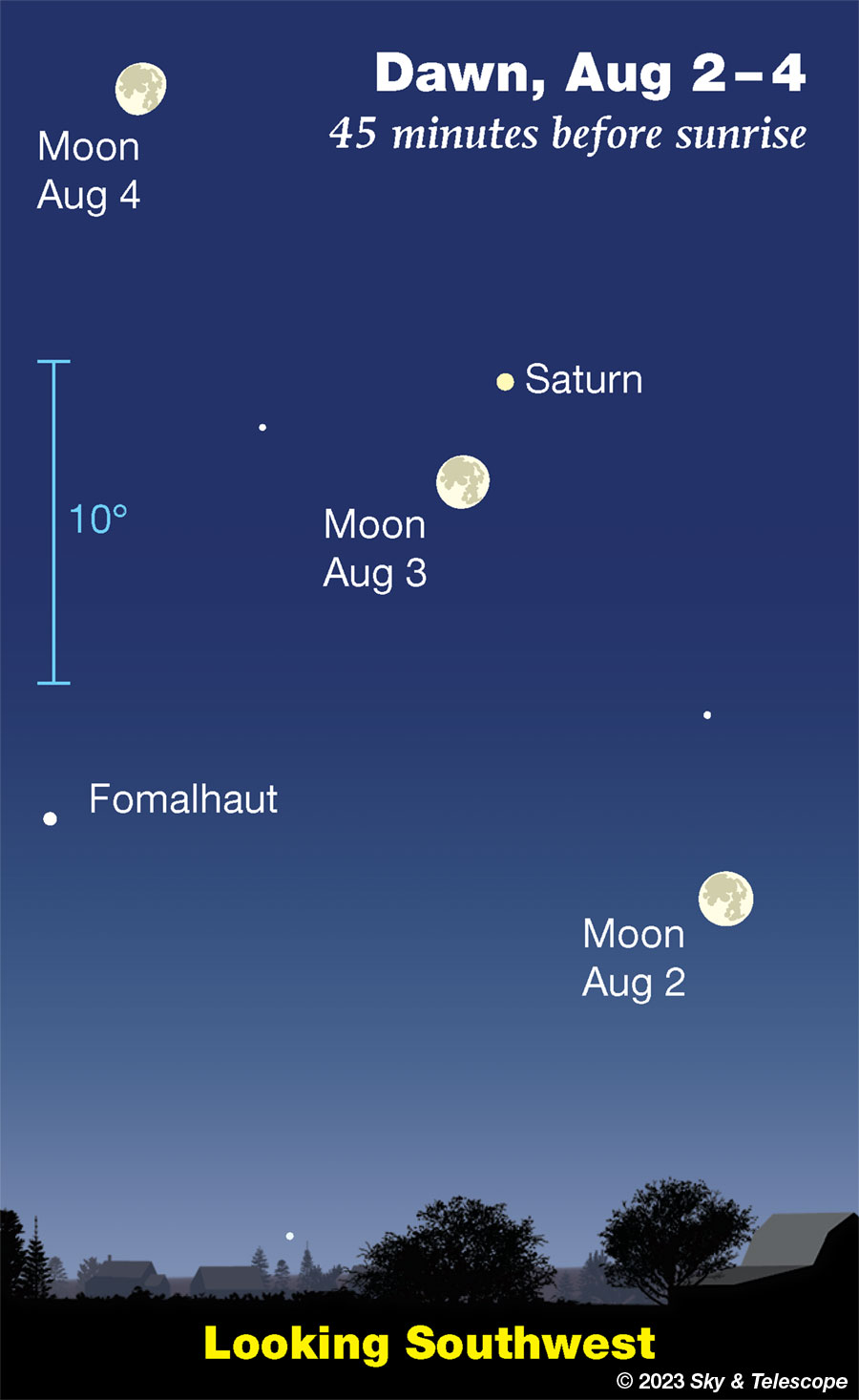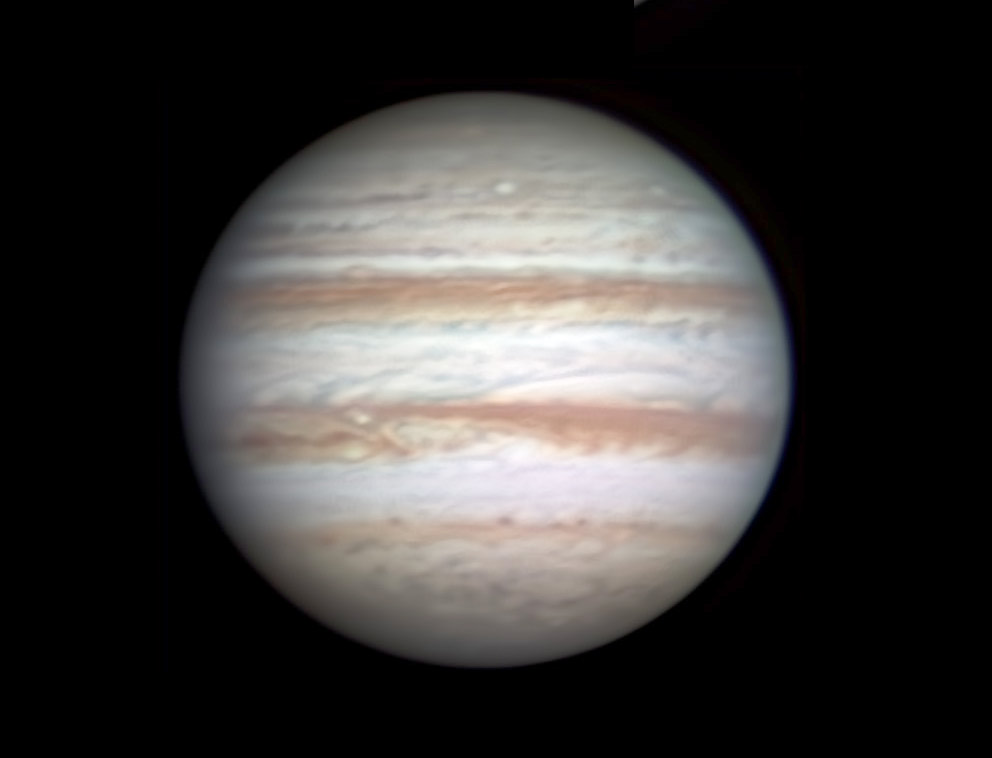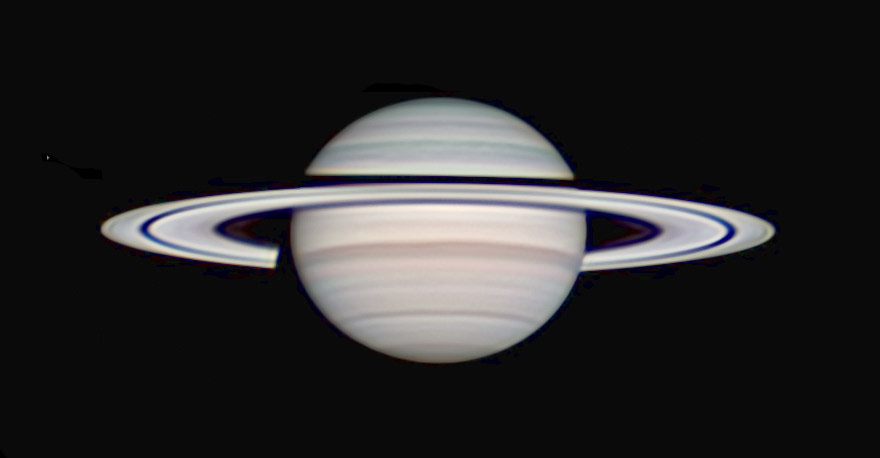Comet 12P/Pons-Brooks in outburst. It was supposed to be 16th or 17th magnitude now, but on July 20th this distant comet brightened 100 times to mag 11 or 12. It's high overhead crossing the head of Draco these evenings, spreading and becoming more diffuse. You may need an 8- or 10-inch scope. More at Bob King's See Comet 12P/Pons-Brooks in Outburst, with pix and finder charts. This comet has a long history of outbursts, so more could happen.
This is a preview. Even if the comet returns to normal and stays there, in the course of its incoming orbit it should reach 4th or 5th magnitude in April 2024, when it will hang low in the west near Jupiter around the end of evening twilight.
FRIDAY, JULY 28
■ This evening the Moon shines just a few degrees left of Antares, as shown below. But of course they're not the slightest bit close together. The Moon is 1.3 light-seconds from us. Antares is some 13 billion times farther away, at a distance of about 550 light-years. Moreover, Antares is estimated to be almost 200,000 times larger than the Moon in diameter. Nowhere in human experience but astronomy are things so different than they appear.

SATURDAY, JULY 29
■ The Moon hangs just off the spout of the Sagittarius Teapot this evening (as shown above) like a giant, dazzling drop that the Teapot spit out. Binoculars may help you pick out the Teapot stars through the moonlight. Remember that the Teapot is about twice as wide as a typical binocular's field of view, so expect to sweep a bit to find it all.
SUNDAY, JULY 30
■ Now the Moon is on the other edge of the Teapot, an overwhelming ornament on its handle. Again, use binocs to help pick the stars out of the moonlight.
MONDAY, JULY 31
■ The two brightest stars of summer are Vega, overhead shortly after nightfall, and Arcturus, shining in the west. Draw a line down from Vega to Arcturus. A third of the way down, the line crosses the dim Keystone of Hercules. Two thirds of the way down the line crosses the dim semicircle of Corona Borealis with its one modestly bright star, Alphecca or Gemma.
Vega and the Keystone's star closest to it form an equilateral triangle with Eltanin to their north, the nose of Draco the Dragon. Eltanin is the brightest star of Draco's quadrilateral head; he's eyeing Vega.
TUESDAY, AUGUST 1
■ Full Moon (exact at 2:23 p.m.) in southern Capricornus. As twilight fades, look for Altair very high over it. Once the Moon is nicely up, look for Saturn two fists at arm's length to its left.
■ As summer progresses, Arcturus always moves down the western side of the evening sky. It forms the bottom point of the Kite of Boötes. The Kite, rather narrow, extends upper right from Arcturus by 23°, about two fists at arm's length.
The top of the kite is bent slightly down. The kite's short tail currently hangs nearly straight down from Arcturus.
WEDNESDAY, AUGUST 2
■ The Moon, now just a day and a fraction past full, rises in late twilight. This evening look for Saturn about 6° to the Moon's left or upper left. They'll draw closer through the night as they wheel across the sky together.

■ We're not quite halfway through summer, but already W-shaped Cassiopeia, a high constellation of fall and winter evenings, is climbing up in the north-northeast as evening grows late. And the Great Square of Pegasus, emblem of fall, comes up to balance on one corner just over the eastern horizon.
THURSDAY, AUGUST 3
■ The waning gibbous Moon rises around the very end of twilight. Saturn glows to its upper right. Farther to the Moon's upper left, the Great Square of Pegasus is balancing on one corner. The Square's top-right edge points down lower right toward the Moon.
FRIDAY, AUGUST 4
■ Fourth star of the Summer Triangle? The next-brightest star near the Summer Triangle, if you'd like to turn it into a quadrilateral, is Rasalhague, the head of Ophiuchus, magnitude 2.1. Face south soon after dark. You'll find Rasalhague about equally far to the right of Altair and lower right of Vega. Altair is currently the Summer Triangle's lowest star. Vega, nearly overhead, is its brightest.
SATURDAY, AUGUST 5
■ Bright Vega passes closest to overhead around 10 or 11 p.m., depending on how far east or west you live in your time zone. How closely it misses your zenith depends on how far north or south you are. It passes right through your zenith if you're at latitude 39° north (Washington DC, Cincinnati, Kansas City, Lake Tahoe). How closely can you judge this just by looking?
Deneb crosses closest to the zenith two hours after Vega. To see Deneb exactly straight up, you need to be at latitude 45° north: for example Portland (either Oregon or Maine), Minneapolis, Montreal, southern France, northern Italy, southern Ukraine.
SUNDAY, AUGUST 6
■ The Big Dipper hangs diagonally in the northwest after dark. From its midpoint, look to the right to find Polaris (not very bright) glimmering due north as always.
Polaris is the end of the Little Dipper's handle. The only other Little Dipper stars that are even modestly bright are the two forming the outer end of its bowl: 2nd-magnitude Kochab and 3rd-magnitude Pherkad. On August evenings you'll find them to Polaris's upper left (by about a fist and a half). They're called the Guardians of the Pole, since they ceaselessly circle around Polaris throughout the night and throughout the year.
■ Seeing any early Perseid meteors yet? A few Perseids trickle in starting in late July, then they build for a couple of days toward their peak, which this year is predicted for the night of August 12-13. The sky then will be moonless for perfect meteor-watching conditions. The weak, long-lasting Delta Aquariid shower is also somewhat active throughout this time. For both, the later in the night the more meteors you'll see. More details to come next week!
This Week's Planet Roundup
Mercury and Venus are very deep in the glow of sunset. Early in the week, use binoculars about 15 or 20 minutes after sunset to start looking for them low above the horizon due west. Venus is about magnitude –4.2. Mercury is only about 1/50 as bright, fading slightly this week from magnitude 0.0 to +0.2, but at least it's higher.
On July 28th Mercury is 6° above Venus. It moves farther away, to 15° upper left of Venus by August 4th, but by then Venus is just plain gone from post-sunset view.
Bonus: on July 28th Mercury is passing very close by fainter Regulus, magnitude +1.4. They'll be only 0.1° or 0.2° apart as seen in twilight from the longitudes of the Americas. Use binoculars or better, a telescope. In a telescope Mercury will be very tiny (6.2 arcseconds diameter) and gibbous.
Venus in a telescope is entering its most extreme crescent phase, when its hair-thin cusps start extending around the planet's circumference toward forming a complete ring. The time to examine Venus telescopically now is in the blue sky of afternoon, when it and the Sun are still high. But when looking for Venus take care not to accidentally sweep up the Sun! Keep your eye safe by setting up your scope at a spot where the Sun has just sunk behind a solid, level obstruction, such as the roofline of a house.
For more about observing this most interesting and challenging Venus phase, see Bob King's thorough View the Thin Crescent of Venus, including daylight finding instructions.
Mars is also nearby! But it's only magnitude +1.8. Look for it 11° upper left of Mercury on July 28th, closing to 7° upper left of Mercury by August 4th. Good luck.
Jupiter (magnitude –2.4, in Aries) rises around midnight or a little after in the east-northeast. By the beginning of dawn it shines very high toward the southeast.

Saturn (magnitude +0.7, in dim Aquarius) rises in late twilight. It's highest in the south, and sharpest and steadiest in a telescope, in the couple hours before dawn.

Uranus, magnitude 5.8 in Aries, is nice and high by the beginning of dawn, about 9° left of Jupiter.
Neptune, magnitude 7.9 at the Aquarius-Pisces border, rises after dark and is high in the south before dawn begins, about 2o° east of Saturn.
All descriptions that relate to your horizon — including the words up, down, right, and left — are written for the world's mid-northern latitudes. Descriptions and graphics that also depend on longitude (mainly Moon positions) are for North America.
Eastern Daylight Time (EDT) is Universal Time minus 4 hours. UT is sometimes called UTC, GMT, or Z time.
Want to become a better astronomer? Learn your way around the constellations. They're the key to locating everything fainter and deeper to hunt with binoculars or a telescope.
This is an outdoor nature hobby. For a more detailed constellation guide covering the whole evening sky, use the big monthly map in the center of each issue of Sky & Telescope, the essential magazine of astronomy.
Once you get a telescope, to put it to good use you'll need a much more detailed, large-scale sky atlas (set of charts). The basic standard is the Pocket Sky Atlas (in either the original or Jumbo Edition), which shows all stars to magnitude 7.6.

Next up is the larger and deeper Sky Atlas 2000.0, plotting stars to magnitude 8.5; nearly three times as many. The next up, once you know your way around, are the even larger Interstellarum atlas (stars to magnitude 9.5) or Uranometria 2000.0 (stars to mag 9.75). And be sure to read How to Use a Star Chart with a Telescope. It applies just as much to charts on your phone or tablet as to charts on paper.
You'll also want a good deep-sky guidebook. A beloved old classic is the three-volume Burnham's Celestial Handbook. An impressive more modern one is the big Night Sky Observer's Guide set (2+ volumes) by Kepple and Sanner.
Do computerized telescopes replace charts? Not for beginners I don't think, especially not on mounts and tripods that are less than top-quality mechanically. Unless you really prefer spending your time getting finicky technology to work rather than getting to know the sky. As Terence Dickinson and Alan Dyer say in their Backyard Astronomer's Guide, "A full appreciation of the universe cannot come without developing the skills to find things in the sky and understanding how the sky works. This knowledge comes only by spending time under the stars with star maps in hand."
But finding very faint objects the old-fashioned way with charts isn't simple either. See How to Use a Star Chart with a Telescope to learn the tricks.
![]() Audio sky tour. Out under the evening sky with your
Audio sky tour. Out under the evening sky with your
earbuds in place, listen to Kelly Beatty's monthly
podcast tour of the naked-eye heavens above. It's free.
"The dangers of not thinking clearly are much greater now than ever before. It's not that there's something new in our way of thinking, it's that credulous and confused thinking can be much more lethal in ways it was never before."
— Carl Sagan, 1996
"Facts are stubborn things."
— John Adams, 1770
 7
7









Comments
misha17
July 29, 2023 at 6:05 am
Ok this comment will be a little long and winding, so bear with me.
1. This week's Full Moon is the first of 2 in August. The second Full Moon in a calendar month is popularly called a "Blue Moon", although traditionally the Farmer's Almanac gave that name to the 3rd Full Moon in a season with 4 Full Moons instead of the usual 3.
2. The converse of the traditional F.A. Blue Moon is a "Black Moon", the 3rd New Moon in a season that has 4 New Moons. Seasons begin around the 20th of a month (March, June, September, December), so a Black Moon also falls around the 20th of the month prior to the start of a season. We had a Black Moon on May 19th of this year, and I commented on it back then.
( https://skyandtelescope.org/observing/sky-at-a-glance/this-weeks-sky-at-a-glance-may-19-28/ )
3. A Full Moon occurs about 15 days after a New Moon, so the Full Moon right after a Black Moon occurs in the first few days of the following month. This year, that Full Moon occurred early in June, on June 3rd.
4. Moon phases occur a day or two earlier each calendar month, so we start with a traditonal Black Moon (this year on May 19th ), followed by a Full Moon early the next month (this year on June 3rd), followed by a Full Moon falling on the 1st or 2nd a couple of months later (this year it's the August "Sturgeon Moon" on the 1st), which is then followed by a calendar Blue Moon at the end of the latter month (this year on August 30th).
~The End(?)~
You must be logged in to post a comment.
misha17
July 29, 2023 at 6:13 am
... as a side note, both Full Moons this month are "Super Moons", which occur when the Full Moon is within a day orctwo of perigee. The Full Moon at the end of August is a little more "super" because it occurs closer to its corresponding perigee date.
You must be logged in to post a comment.
misha17
August 1, 2023 at 1:37 am
Happy Lammastide (August 1st)!
Lammas is the modern name for the Celtic/pagan day, Lughnasadh, one of the quarter days roughly halfway between a solstice and an equinox (the others being Feb 1st, May 1st, and November 1st).
As with the other pagan quarter-days, the Christian church overlaid the date with a minor Christian feast date. "Lammas" is from the Old English and means "Loaf Mass". The bread from the season's first harvest was blessed during the Mass on August 1st.
The actual midpoint between the June solstice and September equinox does not occur until next weekend. Even then, the Sun still is at about 16 degrees north of the Celestial Equator, about 70% of its naximum northern declination. Daylight hours are beginning to get noticeably shorter, but won't really start getting shorter until after mid-August.
You must be logged in to post a comment.
mary beth
August 1, 2023 at 2:11 am
Happy “hlāfmæsse“ to you as well! We are celebrating here tomorrow with fresh baked French bread, and tonight, reading Romeo and Juliet, as her birthday was “Lammas-Eve”.
Very nice it will be a full moon. Also it was already beautiful tonight and looked full to us.
Spica, the grain of wheat in the virgin’s hand, has really moved westward. Love how this all comes together!
Happy August everyone!
You must be logged in to post a comment.
New Jersey Eclipse Fan
August 1, 2023 at 12:10 pm
You guys know what my background is, so I can't relate to this. But my mother (born in Ukraine) would be celebrating her 101st birthday today if she were still alive, so August 1st is special to me nonetheless. And even though my wife's paternal grandmother was born on July 4th (1901), she celebrated her birthday on August 1st for some reason. Despite that, she didn't consider herself a "Yankee Doodle Dandy" because she was born in Vitebsk, Belarus, the same birthplace as artist Marc Chagall.
You must be logged in to post a comment.
mary beth
August 1, 2023 at 2:50 pm
Hi NJEF! Happy August!
I know someone from Ukraine and they’re really big about celebrating their “ name day “ instead of their birthday. Each name has a day so I wonder if your grandmother’s first name corresponded with the name day for August 1. Was her name Marcella or Salome? That’s what I am finding on the name day website for Eastern Europe! There might be different calendar names for different regions.
“Ukrainians exchange gifts with family and close friends on birthdays and the Orthodox Christmas. Name days' (birth date of the saint after whom a person was named) are also celebrated rather than birthdays by some.”
My grandparents were born in Potenza Italy, near Naples, and my mother was born in Forest Hills, New York City in 1928 after they immigrated here. My mother was a full-fledged Yankee Doodle Dandy! She did not like her Italian heritage and was embarrassed of it until she was an adult because the Italian kids were made fun of. They called her spaghetti legs because she was so thin lol.
You must be logged in to post a comment.
mary beth
August 1, 2023 at 2:57 pm
Oops, sorry I got your mother and grandmother-in-law mixed up but pretty much the same Eastern Europe heritage.
Happy Birthday to both sweet souls!
You must be logged in to post a comment.
You must be logged in to post a comment.